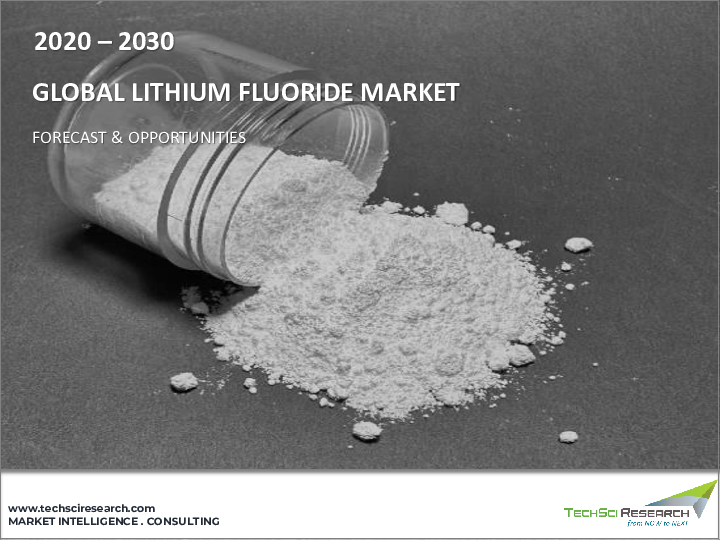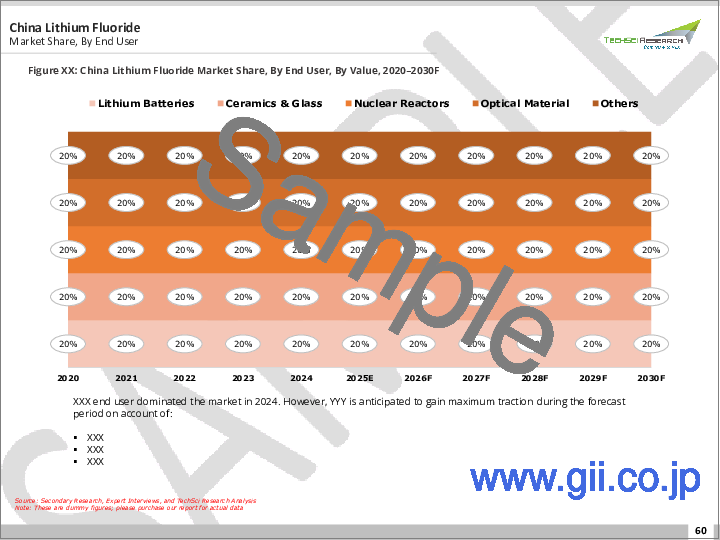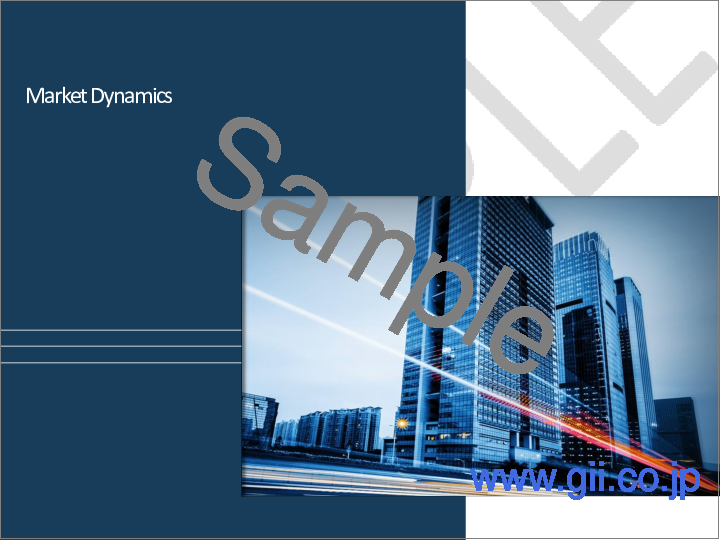|
|
市場調査レポート
商品コード
1719249
フッ化リチウム市場 - 世界の産業規模、シェア、動向、機会、予測、販売チャネル別、最終用途別、地域別、競合別、2020年~2030年Lithium Fluoride Market - Global Industry Size, Share, Trends, Opportunity, and Forecast, Segmented By Sales Channel, By End Use, By Region and Competition, 2020-2030F |
||||||
カスタマイズ可能
|
|||||||
| フッ化リチウム市場 - 世界の産業規模、シェア、動向、機会、予測、販売チャネル別、最終用途別、地域別、競合別、2020年~2030年 |
|
出版日: 2025年04月30日
発行: TechSci Research
ページ情報: 英文 185 Pages
納期: 2~3営業日
|
全表示
- 概要
- 目次
フッ化リチウムの世界市場は、2024年には44億3,885万米ドルとなり、2030年までには69億8,373万米ドルに達すると予測され、予測期間中のCAGRは3.86%で成長すると予測されています。
主要なリチウム化合物であるフッ化リチウム(LiF)は、その高い融点、熱安定性、卓越した耐薬品性により牽引力を増しており、様々な産業で不可欠なものとなっています。需要は、原子力技術、エネルギー貯蔵、工業プロセスの進歩によって推進されています。米国地質調査所(USGS)のデータによると、世界のリチウム供給の大部分はオーストラリアと中国の硬質岩石採掘によるもので、それぞれ49%と17%を占めています。クリーンエネルギーへの取り組みと原子炉の技術革新が加速するにつれ、フッ化リチウムへのニーズは高まっています。しかし、市場の成長は、原料供給リスクと多様で持続可能な調達の必要性によって抑制されています。
| 市場概要 | |
|---|---|
| 予測期間 | 2026年~2030年 |
| 市場規模:2024年 | 44億3,885万米ドル |
| 市場規模:2030年 | 69億8,373万米ドル |
| CAGR:2025年~2030年 | 3.86% |
| 急成長セグメント | 間接 |
| 最大市場 | アジア太平洋 |
主要な市場促進要因
リチウム電池製造におけるフッ化リチウムの使用拡大
主要な市場課題
限られた原材料の入手可能性
主要市場動向
原子力技術の進歩
目次
第1章 製品概要
第2章 調査手法
第3章 エグゼクティブサマリー
第4章 世界のフッ化リチウム市場にCOVID-19が与える影響
第5章 世界のフッ化リチウム市場展望
- 市場規模・予測
- 金額別
- 市場シェア・予測
- 販売チャネル別(直接、間接)
- 最終用途別(リチウム電池、セラミックス・ガラス、原子炉、光学材料、その他)
- 地域別
- 企業別(2024年)
- 市場マップ
第6章 北米のフッ化リチウム市場展望
- 市場規模・予測
- 市場シェア・予測
- 北米:国別分析
- 米国
- メキシコ
- カナダ
第7章 欧州のフッ化リチウム市場展望
- 市場規模・予測
- 市場シェア・予測
- 欧州:国別分析
- フランス
- ドイツ
- 英国
- イタリア
- スペイン
第8章 アジア太平洋のフッ化リチウム市場展望
- 市場規模・予測
- 市場シェア・予測
- アジア太平洋:国別分析
- 中国
- インド
- 韓国
- 日本
- オーストラリア
第9章 南米のフッ化リチウム市場展望
- 市場規模・予測
- 市場シェア・予測
- 南米:国別分析
- ブラジル
- アルゼンチン
- コロンビア
第10章 中東・アフリカのフッ化リチウム市場展望
- 市場規模・予測
- 市場シェア・予測
- 中東・アフリカ:国別分析
- 南アフリカ
- サウジアラビア
- アラブ首長国連邦
第11章 市場力学
- 促進要因
- 課題
第12章 市場動向と発展
- 合併と買収
- 製品上市
- 最近の動向
第13章 世界のフッ化リチウム市場:SWOT分析
第14章 ポーターのファイブフォース分析
- 業界内の競合
- 新規参入の可能性
- サプライヤーの力
- 顧客の力
- 代替品の脅威
第15章 競合情勢
- Anhui Fitech Materials Co., Ltd
- Shandong Yinglang Chemical Co.,Ltd
- Hubei Baijierui Advanced Materials Co., Ltd
- Tinci Materials Technology Co., Ltd
- Baiyin Zhongtian Co Ltd
- Jiangxi Dongpeng New Materials Co., Ltd
- Shandong Lingkai Pharmaceuticals Co Ltd.
- Ganzhou Songhui New Fluorine Material Co., Ltd
- Taixing Best New Materials Co., Ltd
- Dofluoropoly Chemical Co., Ltd
第16章 戦略的提言
第17章 調査会社について・免責事項
The Global Lithium Fluoride Market was valued at USD 4,438.85 Million in 2024 and is projected to reach USD 6,983.73 Million by 2030, growing at a CAGR of 3.86% during the forecast period. Lithium fluoride (LiF), a key lithium compound, is gaining increased traction due to its high melting point, thermal stability, and exceptional chemical resistance, making it indispensable across several industries. Demand is being propelled by advancements in nuclear technology, energy storage, and industrial processes. According to data from the United States Geological Survey (USGS), most global lithium supply stems from hard rock mining in Australia and China, contributing 49% and 17% respectively, while lithium-rich brines in Chile and Argentina provide 22% and 8%. As clean energy initiatives and nuclear reactor innovations accelerate, the need for lithium fluoride is growing. However, market growth is tempered by raw material supply risks and the need for diversified and sustainable sourcing.
| Market Overview | |
|---|---|
| Forecast Period | 2026-2030 |
| Market Size 2024 | USD 4,438.85 Million |
| Market Size 2030 | USD 6,983.73 Million |
| CAGR 2025-2030 | 3.86% |
| Fastest Growing Segment | Indirect |
| Largest Market | Asia Pacific |
Key Market Drivers
Growing Use of Lithium Fluoride in Making Lithium Batteries
The increasing adoption of lithium fluoride in lithium-ion battery production is a major driver of the market. LiF is critical in the development of solid-state electrolytes that outperform conventional liquid electrolytes in terms of energy density, thermal stability, and safety. Advancements in battery technologies, including fluoride-based batteries previously limited to high-temperature conditions, now allow room-temperature applications, expanding the scope of usage. Notably, lithium's electropositive nature complements fluoride's electronegativity, making their combination highly suitable for stable electrochemical performance. In 2023, researchers at Argonne National Laboratory introduced a novel electrolyte for lithium metal batteries used in electric vehicles, improving range, reducing costs, and enhancing safety. As electric mobility and renewable energy storage infrastructure continue to grow, lithium fluoride's role in advanced battery systems is expected to expand significantly.
Key Market Challenges
Limited Raw Material Availability
The concentration of lithium reserves in a limited number of countries-primarily Australia, Chile, Argentina, and China-poses a considerable supply risk for the lithium fluoride market. This geographical limitation exposes global supply chains to geopolitical tensions, trade policies, and resource nationalism. Disruptions in lithium mining or export from any of these key producers can result in significant market volatility. Moreover, environmental concerns related to lithium extraction-such as water consumption, land disruption, and chemical runoff-have led to stricter regulations and delays in mining approvals, increasing production costs and impeding supply growth. These factors present a major challenge to the scalability and sustainability of lithium fluoride supply in the years ahead.
Key Market Trends
Advancements in Nuclear Energy Technologies
The revival of molten salt reactor (MSR) technology is emerging as a transformative trend in the lithium fluoride market. MSRs, which use mixtures of lithium fluoride and other fluorides as both coolants and fuel solvents, offer enhanced efficiency, superior safety features, and low operating pressures compared to traditional reactors. The high thermal conductivity and chemical resilience of lithium fluoride make it an ideal candidate for use in such advanced reactor designs. Governments and private enterprises in countries including the U.S., China, and Canada are heavily investing in MSR development and pilot projects, increasing the demand for lithium fluoride. These reactors are pivotal to the future of clean nuclear energy, further cementing lithium fluoride's strategic importance in energy transition initiatives.
Key Market Players
- Anhui Fitech Materials Co., Ltd
- Shandong Yinglang Chemical Co., Ltd
- Hubei Baijierui Advanced Materials Co., Ltd
- Tinci Materials Technology Co., Ltd
- Baiyin Zhongtian Co. Ltd
- Jiangxi Dongpeng New Materials Co., Ltd
- Shandong Lingkai Pharmaceuticals Co. Ltd
- Ganzhou Songhui New Fluorine Material Co., Ltd
- Taixing Best New Materials Co., Ltd
- Dofluoropoly Chemical Co., Ltd
Report Scope
In this report, the Global Lithium Fluoride Market has been segmented into the following categories, in addition to the industry trends which have also been detailed below:
Lithium Fluoride Market, By Sales Channel:
- Direct
- Indirect
Lithium Fluoride Market, By End Use:
- Lithium Batteries
- Ceramics & Glass
- Nuclear Reactors
- Optical Material
- Others
Lithium Fluoride Market, By Region:
- North America
- United States
- Canada
- Mexico
- Europe
- France
- United Kingdom
- Italy
- Germany
- Spain
- Asia Pacific
- China
- India
- Japan
- Australia
- South Korea
- South America
- Brazil
- Argentina
- Colombia
- Middle East & Africa
- South Africa
- Saudi Arabia
- UAE
Competitive Landscape
Company Profiles: Detailed analysis of the major companies present in the Global Lithium Fluoride Market.
Available Customizations
Global Lithium Fluoride Market report with the given market data, TechSci Research offers customizations according to a company's specific needs. The following customization options are available for the report:
Company Information
- Detailed analysis and profiling of additional market players (up to five).
Table of Contents
1. Product Overview
- 1.1. Market Definition
- 1.2. Scope of the Market
- 1.2.1. Markets Covered
- 1.2.2. Years Considered for Study
- 1.2.3. Key Market Segmentations
2. Research Methodology
- 2.1. Objective of the Study
- 2.2. Baseline Methodology
- 2.3. Key Industry Partners
- 2.4. Major Association and Secondary Sources
- 2.5. Forecasting Methodology
- 2.6. Data Triangulation & Validation
- 2.7. Assumptions and Limitations
3. Executive Summary
- 3.1. Overview of the Market
- 3.2. Overview of Key Market Segmentations
- 3.3. Overview of Key Market Players
- 3.4. Overview of Key Regions/Countries
- 3.5. Overview of Market Drivers, Challenges, and Trends
4. Impact of COVID-19 on Global Lithium Fluoride Market
5. Global Lithium Fluoride Market Outlook
- 5.1. Market Size & Forecast
- 5.1.1. By Value
- 5.2. Market Share & Forecast
- 5.2.1. By Sales Channel (Direct, Indirect)
- 5.2.2. By End Use (Lithium Batteries, Ceramics & Glass, Nuclear Reactors, Optical Material, Others)
- 5.2.3. By Region
- 5.2.4. By Company (2024)
- 5.3. Market Map
6. North America Lithium Fluoride Market Outlook
- 6.1. Market Size & Forecast
- 6.1.1. By Value
- 6.2. Market Share & Forecast
- 6.2.1. By Sales Channel
- 6.2.2. By End Use
- 6.2.3. By Country
- 6.3. North America: Country Analysis
- 6.3.1. United States Lithium Fluoride Market Outlook
- 6.3.1.1. Market Size & Forecast
- 6.3.1.1.1. By Value
- 6.3.1.2. Market Share & Forecast
- 6.3.1.2.1. By Sales Channel
- 6.3.1.2.2. By End Use
- 6.3.1.1. Market Size & Forecast
- 6.3.2. Mexico Lithium Fluoride Market Outlook
- 6.3.2.1. Market Size & Forecast
- 6.3.2.1.1. By Value
- 6.3.2.2. Market Share & Forecast
- 6.3.2.2.1. By Sales Channel
- 6.3.2.2.2. By End Use
- 6.3.2.1. Market Size & Forecast
- 6.3.3. Canada Lithium Fluoride Market Outlook
- 6.3.3.1. Market Size & Forecast
- 6.3.3.1.1. By Value
- 6.3.3.2. Market Share & Forecast
- 6.3.3.2.1. By Sales Channel
- 6.3.3.2.2. By End Use
- 6.3.3.1. Market Size & Forecast
- 6.3.1. United States Lithium Fluoride Market Outlook
7. Europe Lithium Fluoride Market Outlook
- 7.1. Market Size & Forecast
- 7.1.1. By Value
- 7.2. Market Share & Forecast
- 7.2.1. By Sales Channel
- 7.2.2. By End Use
- 7.2.3. By Country
- 7.3. Europe: Country Analysis
- 7.3.1. France Lithium Fluoride Market Outlook
- 7.3.1.1. Market Size & Forecast
- 7.3.1.1.1. By Value
- 7.3.1.2. Market Share & Forecast
- 7.3.1.2.1. By Sales Channel
- 7.3.1.2.2. By End Use
- 7.3.1.1. Market Size & Forecast
- 7.3.2. Germany Lithium Fluoride Market Outlook
- 7.3.2.1. Market Size & Forecast
- 7.3.2.1.1. By Value
- 7.3.2.2. Market Share & Forecast
- 7.3.2.2.1. By Sales Channel
- 7.3.2.2.2. By End Use
- 7.3.2.1. Market Size & Forecast
- 7.3.3. United Kingdom Lithium Fluoride Market Outlook
- 7.3.3.1. Market Size & Forecast
- 7.3.3.1.1. By Value
- 7.3.3.2. Market Share & Forecast
- 7.3.3.2.1. By Sales Channel
- 7.3.3.2.2. By End Use
- 7.3.3.1. Market Size & Forecast
- 7.3.4. Italy Lithium Fluoride Market Outlook
- 7.3.4.1. Market Size & Forecast
- 7.3.4.1.1. By Value
- 7.3.4.2. Market Share & Forecast
- 7.3.4.2.1. By Sales Channel
- 7.3.4.2.2. By End Use
- 7.3.4.1. Market Size & Forecast
- 7.3.5. Spain Lithium Fluoride Market Outlook
- 7.3.5.1. Market Size & Forecast
- 7.3.5.1.1. By Value
- 7.3.5.2. Market Share & Forecast
- 7.3.5.2.1. By Sales Channel
- 7.3.5.2.2. By End Use
- 7.3.5.1. Market Size & Forecast
- 7.3.1. France Lithium Fluoride Market Outlook
8. Asia Pacific Lithium Fluoride Market Outlook
- 8.1. Market Size & Forecast
- 8.1.1. By Value
- 8.2. Market Share & Forecast
- 8.2.1. By Sales Channel
- 8.2.2. By End Use
- 8.2.3. By Country
- 8.3. Asia Pacific: Country Analysis
- 8.3.1. China Lithium Fluoride Market Outlook
- 8.3.1.1. Market Size & Forecast
- 8.3.1.1.1. By Value
- 8.3.1.2. Market Share & Forecast
- 8.3.1.2.1. By Sales Channel
- 8.3.1.2.2. By End Use
- 8.3.1.1. Market Size & Forecast
- 8.3.2. India Lithium Fluoride Market Outlook
- 8.3.2.1. Market Size & Forecast
- 8.3.2.1.1. By Value
- 8.3.2.2. Market Share & Forecast
- 8.3.2.2.1. By Sales Channel
- 8.3.2.2.2. By End Use
- 8.3.2.1. Market Size & Forecast
- 8.3.3. South Korea Lithium Fluoride Market Outlook
- 8.3.3.1. Market Size & Forecast
- 8.3.3.1.1. By Value
- 8.3.3.2. Market Share & Forecast
- 8.3.3.2.1. By Sales Channel
- 8.3.3.2.2. By End Use
- 8.3.3.1. Market Size & Forecast
- 8.3.4. Japan Lithium Fluoride Market Outlook
- 8.3.4.1. Market Size & Forecast
- 8.3.4.1.1. By Value
- 8.3.4.2. Market Share & Forecast
- 8.3.4.2.1. By Sales Channel
- 8.3.4.2.2. By End Use
- 8.3.4.1. Market Size & Forecast
- 8.3.5. Australia Lithium Fluoride Market Outlook
- 8.3.5.1. Market Size & Forecast
- 8.3.5.1.1. By Value
- 8.3.5.2. Market Share & Forecast
- 8.3.5.2.1. By Sales Channel
- 8.3.5.2.2. By End Use
- 8.3.5.1. Market Size & Forecast
- 8.3.1. China Lithium Fluoride Market Outlook
9. South America Lithium Fluoride Market Outlook
- 9.1. Market Size & Forecast
- 9.1.1. By Value
- 9.2. Market Share & Forecast
- 9.2.1. By Sales Channel
- 9.2.2. By End Use
- 9.2.3. By Country
- 9.3. South America: Country Analysis
- 9.3.1. Brazil Lithium Fluoride Market Outlook
- 9.3.1.1. Market Size & Forecast
- 9.3.1.1.1. By Value
- 9.3.1.2. Market Share & Forecast
- 9.3.1.2.1. By Sales Channel
- 9.3.1.2.2. By End Use
- 9.3.1.1. Market Size & Forecast
- 9.3.2. Argentina Lithium Fluoride Market Outlook
- 9.3.2.1. Market Size & Forecast
- 9.3.2.1.1. By Value
- 9.3.2.2. Market Share & Forecast
- 9.3.2.2.1. By Sales Channel
- 9.3.2.2.2. By End Use
- 9.3.2.1. Market Size & Forecast
- 9.3.3. Colombia Lithium Fluoride Market Outlook
- 9.3.3.1. Market Size & Forecast
- 9.3.3.1.1. By Value
- 9.3.3.2. Market Share & Forecast
- 9.3.3.2.1. By Sales Channel
- 9.3.3.2.2. By End Use
- 9.3.3.1. Market Size & Forecast
- 9.3.1. Brazil Lithium Fluoride Market Outlook
10. Middle East and Africa Lithium Fluoride Market Outlook
- 10.1. Market Size & Forecast
- 10.1.1. By Value
- 10.2. Market Share & Forecast
- 10.2.1. By Sales Channel
- 10.2.2. By End Use
- 10.2.3. By Country
- 10.3. MEA: Country Analysis
- 10.3.1. South Africa Lithium Fluoride Market Outlook
- 10.3.1.1. Market Size & Forecast
- 10.3.1.1.1. By Value
- 10.3.1.2. Market Share & Forecast
- 10.3.1.2.1. By Sales Channel
- 10.3.1.2.2. By End Use
- 10.3.1.1. Market Size & Forecast
- 10.3.2. Saudi Arabia Lithium Fluoride Market Outlook
- 10.3.2.1. Market Size & Forecast
- 10.3.2.1.1. By Value
- 10.3.2.2. Market Share & Forecast
- 10.3.2.2.1. By Sales Channel
- 10.3.2.2.2. By End Use
- 10.3.2.1. Market Size & Forecast
- 10.3.3. UAE Lithium Fluoride Market Outlook
- 10.3.3.1. Market Size & Forecast
- 10.3.3.1.1. By Value
- 10.3.3.2. Market Share & Forecast
- 10.3.3.2.1. By Sales Channel
- 10.3.3.2.2. By End Use
- 10.3.3.1. Market Size & Forecast
- 10.3.1. South Africa Lithium Fluoride Market Outlook
11. Market Dynamics
- 11.1. Drivers
- 11.2. Challenges
12. Market Trends & Developments
- 12.1. Merger & Acquisition (If Any)
- 12.2. Product Launches (If Any)
- 12.3. Recent Developments
13. Global Lithium Fluoride Market: SWOT Analysis
14. Porters Five Forces Analysis
- 14.1. Competition in the Industry
- 14.2. Potential of New Entrants
- 14.3. Power of Suppliers
- 14.4. Power of Customers
- 14.5. Threat of Substitute Products
15. Competitive Landscape
- 15.1. Anhui Fitech Materials Co., Ltd
- 15.1.1. Business Overview
- 15.1.2. Company Snapshot
- 15.1.3. Products & Services
- 15.1.4. Financials (As Reported)
- 15.1.5. Recent Developments
- 15.1.6. Key Personnel Details
- 15.1.7. SWOT Analysis
- 15.2. Shandong Yinglang Chemical Co.,Ltd
- 15.3. Hubei Baijierui Advanced Materials Co., Ltd
- 15.4. Tinci Materials Technology Co., Ltd
- 15.5. Baiyin Zhongtian Co Ltd
- 15.6. Jiangxi Dongpeng New Materials Co., Ltd
- 15.7. Shandong Lingkai Pharmaceuticals Co Ltd.
- 15.8. Ganzhou Songhui New Fluorine Material Co., Ltd
- 15.9. Taixing Best New Materials Co., Ltd
- 15.10. Dofluoropoly Chemical Co., Ltd




